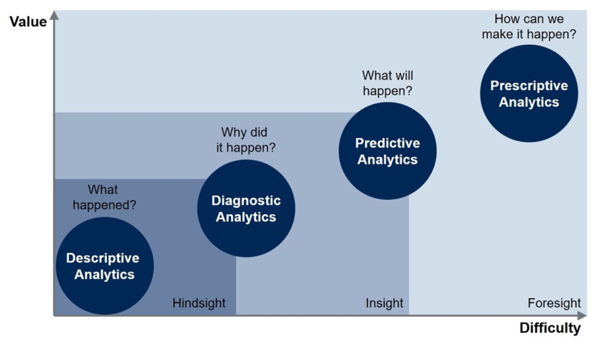Current State Analysis: Data Outcomes
This article is the fifth in a series taking a deep dive on how to do a Current State Analysis on your data. This article focusses on Data Outcomes: what they are, why they are important, and what questions to ask to determine the current state.
The questions are organized by stakeholder group to facilitate usability; hopefully you can use this as a template to start your Current State Analysis journey. A few definitions before we begin — note that these groups are not mutually exclusive.
People who Input Data: These are people who collect and/or input data into the system. For example, salespeople inputting their sales numbers, or survey creators.
People who Manipulate and Analyze Data: These are people who organize the data and create analyses. This includes Data Engineers, Business Intelligence Professionals, and Data Analysts.
People who Make Decisions based on Data: These are the people who use the data to make decisions. This may be a sales manager deciding where to invest resources, a product manager understanding product use demographics, or an executive trying to cut costs.
What are Data Outcomes?
Data Outcomes refer to the way that you use your data. Why do you want data? What decisions are you making with it? Is it a revenue driver?
When organizations decide that they want to be "data-driven" this is usually what they are referring to. Leadership expects people to be able to look at data and quickly make operational, sales, or investment decisions. Even better, they hope that their data can predict trends and even automatically prescribe decisions through Machine Learning. Gartner's Analytic Value Escalator[1] says it best:

Why are Data Outcomes Important?
Data Outcomes are important because this is the last mile of data. You've set up all the infrastructure, made sure that data is trustworthy and reliable, gotten everyone excited about the new tools and processes. The last and most important step is to use it to make decisions about your business.
Questions to Determine the Current State of Data Outcomes
To Those Who Input Data
These questions are designed to measure two things: whether people who are inputting data understand the value of the data that they input, and if they have identified other valuable data that we are not capturing.
People who input data are often not the recipients of data. They input data, and faceless people in the organization read it, make decisions, and send mandates back. This can be very opaque and demoralizing and discourage people from consistently and accurately inputting data. A preferable situation would be for them to see aggregate dashboards of this data, especially if it affected their work, and let them draw their own conclusions. For example, if a Customer Success person collects a feedback rating from their call, they could receive a weekly update of their aggregate ratings for the week. This would help them get a better sense of their performance and adjust before their manager gets involved. It also encourages them to improve data collection (feeling motivated to ask the customer for their rating) instead of the data going into a black box that only their manager sees.
Additionally, people who are inputting data are usually the closest to the operations that the organization is trying to monitor. They often are the first to see issues or trends and have already optimized their work to account for them. It is important to continually ask people closest to the operations about the data that they think we should collect.
- Is there a closed information loop that informs you about decisions that are being made or revenue that is coming in based on the work that you do and the data you input?
- What data do you have that could be helpful to company goals but that you're currently not putting through the regular data intake process?
To Those Who Manipulate and Analyze Data
Analysts and Data Scientists are often the people who have seen the most metrics in the organization. They know who is interested in what kind of data and what questions keep the executives up at night. Although they may not be the person making ultimate decisions, they are the ones who are pulling, analyzing, and interpreting the data for leadership. These questions are meant to better understand the metrics that they handle and whether they are in line with organization-wide goals.
- Are your analyses aligned to company and department goals?
- Who are you partnering with to create analyses? Which stakeholders are using your analyses and dashboards regularly?
- What analyses do you think need to be made in the future to support KPIs and company goals?
- On the Gartner Analytic Value Escalator, where do you think the organization currently sits?
To Those Who Make Decisions based on Data
These are the main stakeholders of Data Outcomes conversations. They are the ones who are making the decisions and know if their needs are being met. They also likely have a sense of the long-term vision for data — what do they hope data can do for the organization?
- What is the main purpose of data at this organization? Is it an internal tool? A revenue driver? Used to fundraise?
- What decisions are made using data?
- How do you want data to grow? How can it be more helpful to this organization?
- What are your most used analyses and dashboards currently? What analyses or dashboards would increase your efficiency or potentially open new business paths (e.g., Revenue streams, process changes, etc.)
Conclusion
Data Outcomes are the final step for the data. That's not to say that there is nothing to improve from here but more that, once you have Data Quality, Freshness, and Culture, this is the last mile to being a data-driven organization. There are different types of Data Outcomes, from Descriptive to Prescriptive, but it is important that the data is somewhere along that spectrum. The data does no one any good sitting quality-checked and constantly refreshing in a Data Warehouse — make sure the data is helping you move your organization forward!
References
[1] Jason McNellis, “You’re likely investing a lot in marketing analytics, but are you getting the right insights?” https://blogs.gartner.com/jason-mcnellis/2019/11/05/youre-likely-investing-lot-marketing-analytics-getting-right-insights/
# # #
About our Contributor:
Online Interactive Training Series
In response to a great many requests, Business Rule Solutions now offers at-a-distance learning options. No travel, no backlogs, no hassles. Same great instructors, but with schedules, content and pricing designed to meet the special needs of busy professionals.












How to Define Business Terms in Plain English: A Primer
How to Use DecisionSpeak™ and Question Charts (Q-Charts™)
Decision Tables - A Primer: How to Use TableSpeak™
Tabulation of Lists in RuleSpeak®: A Primer - Using "The Following" Clause
Business Agility Manifesto
Business Rules Manifesto
Business Motivation Model
Decision Vocabulary
[Download]
[Download]
Semantics of Business Vocabulary and Business Rules